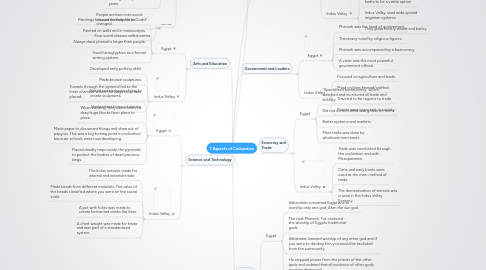
1. Science and Technology
1.1. Egypt
1.1.1. Tunnels through the pyramid led to the inner chamber where the kings body was placed.
1.1.2. When building, they used rollers to drag huge blocks from place to place.
1.1.3. Made paper to document things and draw out of papyrus. This was a big turning point in civilization because schools were now developing.
1.1.4. Placed deadly traps inside the pyramids to protect the bodies of dead previous kings.
1.2. Indus Valley
1.2.1. The Indus sea was made for internal and external trade.
1.2.2. Made beads from different materials. The value of the beads classified where you were on the social scale.
1.2.3. A pot with holes was made to create fermented drinks like beer.
1.2.4. A chert weight was made for trade and was part of a standardized system.
2. Arts and Education
2.1. Egypt
2.1.1. Paintings focused on daily life or Gods.
2.1.2. Painted on walls and in manuscripts.
2.1.3. Always drew pharoahs larger than people.
2.1.4. Used hieroglyphics as a formal writing system.
2.2. Indus Valley
2.2.1. Developed early pottery skills.
2.2.2. Made bronze sculptures.
2.2.3. Baked certain types of clay to create sculptures.
2.2.4. Had earliest forms of writing.
3. Social Structure and Family Life
3.1. Egypt
3.1.1. Egyptian society was structured like a pyramid.
3.1.2. By age 14, ancient Egyptians were considered adults and would have jobs, be married, and have families of there own by then.
3.1.3. Education was a luxury and mostly royal and or wealthy children had that privileged.
3.1.4. Average life span of 45-45 years
3.2. Indus Valley
3.2.1. People are born into social classes that cannot be changed
3.2.2. Four social classes called varnas
4. Geography and Agriculture
4.1. Egypt
4.1.1. The Egyptian civilization was on the Nile river
4.1.2. The river gave the Egyptians fertile lands
4.1.3. Egyptians developed basin irragation
4.1.4. Mostly grains were grown by the Egyptians
4.2. Indus Valley
4.2.1. The Indus valley civilization encompassed part of the middle east.
4.2.2. Proximity to the river allowed boats to be a viable option
4.2.3. Indus Valley used wide spread irrigation systems
4.2.4. They grew mostly wheat and barley
5. Government and Leaders
5.1. Egypt
5.1.1. Pharoah was the head of government.
5.1.2. Theocracy-ruled by religious figures.
5.1.3. Pharoah was accompanied by a buerocracy.
5.1.4. A vizier was the most powerful government official.
5.2. Indus Valley
5.2.1. Focused on agriculture and trade.
5.2.2. Most civilians farmed/crafted.
5.2.3. Traveled to far regions to trade.
5.2.4. Priests were important in society.
6. Economy and Trade
6.1. Egypt
6.1.1. "Specialized bureaucracy" which watched and monitored all trade and activity
6.1.2. Did not control what was grown on farms
6.1.3. Barter systems and markets
6.1.4. Most trade was done by wholesale merchants
6.2. Indus Valley
6.2.1. Trade was conducted through the civilization and with Mesopotamia
6.2.2. Carts and early boats were used as the main method of trade
6.2.3. The domestication of animals was crucial in the Indus Valley Ecnomy
7. Religion
7.1. Egypt
7.1.1. Akhenaten converted Egyptians to worship only one god, Aten the sun god.
7.1.2. The next Pharaoh, Tut, restored the worship of Egypts traditional gods.
7.1.3. Akhenaten banned worship of any other god and if you were to disobey him you would be excluded from the community.
7.1.4. He stripped power from the priests of the other gods and ordered that all evidence of other gods must be destroyed.
7.2. Indus Valley
7.2.1. Worshiped female powers also known as goddesses.
7.2.2. A massive brick platform was made for public rituals.
7.2.3. Made female figurines for goddesses so they could worship them properly. Idolized them and acted as if they were the actual goddess herself.
7.2.4. Special areas were set aside as shrine rooms for what were thought to be domestic cults.
